|
March
Important
historic dates in science
March
31: Sir Lawrence Bragg
(Born March 31, 1890: Died July 1, 1971)
Australian-born British physicist and X-ray crystallographer, who at the
early age of 25, shared the Nobel Prize for Physics in 1915 (with his
father, Sir William Bragg). Lawrence Bragg formulated the Bragg law of
X-ray diffraction, which is basic for the determination of crystal structure:
n[lambda] = 2dsin[theta] which relates the wavelength of x-rays [lambda],
the angle of incidence on a crystal [theta], and the spacing of crystal
planes d, for x-ray diffraction, where n is an integer (1, 2, 3, etc.).
Together, the Braggs worked out the crystal structures of a number of
substances. Early in this work, they showed that sodium chloride does
not have individual molecules in the solid, but is an array of sodium
and chloride ions.
March
30: Auguste Bravais
(Born August 23, 1811,
Died March 30, 1863)
French physicist and mineralogist, best remembered for his work on the
lattice theory of crystals. Bravais lattices are named for him. In 1850,
he showed that crystals could be divided into 14 unit cells for which:
(a) the unit cell is the simplest repeating unit in the crystal; (b) opposite
faces of a unit cell are parallel; and (c) the edge of the unit cell connects
equivalent points. These unit cells fall into seven geometrical categories,
which differ in their relative edge lengths and internal angles. In 1866,
he elaborated the relationships between the ideal lattice and the material
crystal. Sixty years later, Bravais' work provided the mathematical and
conceptual basis for the determination of crystal structures after Laue's
discovery of X-ray diffraction in 1911.
March
29: French nuclear submarine
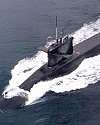 In
1967, the French Navy launched Le Redoutable, its first ballistic missile
nuclear-powered submarine, in the presence of General de Gaulle at the
Cherbourg naval shipyard. It entered service 1 Dec 1971 with 16 MSBS M-1
missiles aboard. Measuring 128.70 meters long and 10.60 meters wide, Le
Redoutable had a top speed (submerged) of 25 knots. After 20 years of
service, it was retired in 1991, after 58 patrols and 90,000 hours under
water. It was disarmed, and opened for display to the public at La Cité
de la Mer, Cherbourg. In
1967, the French Navy launched Le Redoutable, its first ballistic missile
nuclear-powered submarine, in the presence of General de Gaulle at the
Cherbourg naval shipyard. It entered service 1 Dec 1971 with 16 MSBS M-1
missiles aboard. Measuring 128.70 meters long and 10.60 meters wide, Le
Redoutable had a top speed (submerged) of 25 knots. After 20 years of
service, it was retired in 1991, after 58 patrols and 90,000 hours under
water. It was disarmed, and opened for display to the public at La Cité
de la Mer, Cherbourg.
March
28: Nuclear Accident
In 1979, a nuclear accident occured at the Three
Mile Island nuclear power plant outside Harrisburg, Pennsylvania,
USA. Caused by human and mechanical errors, a cooling system malfunctioned
and permitted a partial meltdown of the reactor's core. Some radioactivity
leaked into the atmosphere. Although it is the worst U.S. nuclear accident,
disaster was avoided.
March
27: Wilhelm Conrad Röntgen
(Born March 27, 1845: Died February 10, 1923)
German physicist who was a recipient of the first Nobel Prize for Physics,
in 1901, for his discovery of X rays, which heralded the age of modern
physics and revolutionized diagnostic medicine.
March
26: Edward U. Condon
(Born March 2, 1902: Died March 26, 1974)
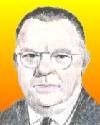 Edward
U(hler) Condon was an American physicist for whom the Franck-Condon principle
was named (1928) and who applied quantum mechanics to an understanding
of atomic, molecular and nuclear structure.The Franck-Condon principle
(1928) is a quantum-mechanical treatment of the earlier statement by James
Franck (1925) that in any molecular system the transition from one energy
state to another occurs so near to instantaneously that the nuclei of
the atoms involved are stationary. In 1943 he helped J. Robert Oppenheimer
recruit the group that made the first atomic bombs at Los Alamos, N.M. Edward
U(hler) Condon was an American physicist for whom the Franck-Condon principle
was named (1928) and who applied quantum mechanics to an understanding
of atomic, molecular and nuclear structure.The Franck-Condon principle
(1928) is a quantum-mechanical treatment of the earlier statement by James
Franck (1925) that in any molecular system the transition from one energy
state to another occurs so near to instantaneously that the nuclei of
the atoms involved are stationary. In 1943 he helped J. Robert Oppenheimer
recruit the group that made the first atomic bombs at Los Alamos, N.M.
March
25: Radium
In 1903, The Times newspaper reported that the French physicist, Pierre
Curie assisted by Mme Curie, communicated to the Academy of Sciences that
the recently discovered Radium "possesses the extraordinary property
of continuously emitting heat, without combustion, without chemical change
of any kind, and without any change to its molecular structure, which
remains spectroscopically identical after many months of continuous emission
of heat ... such that the pure Radium salt would melt more than its own
weight of ice every hour ... A small tube containing Radium, if kept in
contact with the skin for some hours ... produces an open sore, by destroying
the epidermis and the true skin beneath ... and cause the death of living
things whose nerve centres do not lie deep enough to be shielded from
their influence.
March
24: Peter Debye
(Born March 24, 1884: Died November 2, 1966)
Petrus (Peter) Josephus Wilhelmus Debye was a Dutch physical chemist whose
investigations of dipole moments, X rays, and light scattering in gases
brought him the 1936 Nobel Prize for Chemistry. Most of his work was in
chemical-physics with special interest in electrolytes and dipolar momentum
analysis. He established a theory of specific heat with some improvements
on that proposed by Einstein. Debye performed important work in the analysis
of crystalline powders using X-ray diffraction techniques. He also determined
the dimensions of gaseous molecules and the interatomic distances using
X-rays.
March
23: Cold Fusion
In 1989, two Utah scientists claimed they have produced fusion at room
temperature. Martin Fleischmann and Stan Pons announced in Utah how they
had sustained a controlled nuclear fusion reaction in a test-tube that
generated up to 100 per cent more energy than they put in. Then followed
efforts to replicate the work. Leading scientists failed. There were sporadic
sightings of excess heat, which Fleischmann said cannot be accounted for
by chemistry alone. Crucially, there were no tell-tale signs of nuclear
processes, notably subatomic particles called neutrons. Thus, the idea
of cold fusion has been discredited.
March
22: Robert Andrews Millikan
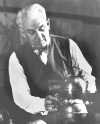 (Born
March 22, 1868: Died December 19, 1953) (Born
March 22, 1868: Died December 19, 1953)
American physicist honoured with the Nobel Prize for Physics in 1923 for
his study of the elementary electronic charge and the photoelectric effect.
He measured the charge of single electrons with his famous oil-drop experiment
in 1911. He coined the term "cosmic rays" during his study of
the radiation from outer space.
March
21: Plutonium named
In 1942, a secret report was submitted suggesting the name "plutonium"
for artificial element 94 since it followed neptunium and uranium (elements
93 and 92). The symbols Pu and Np were also suggestions. The paper was
held secret until after WW II, when it was published by the Journal of
the American Chemical Society in 1948. The authors were Glenn Seaborg
and Arthur C. Wahl. Since McMillan and Abelson had named neptunium after
the planet that lies outside of the orbit of Uranus, the name for the
next element in the periodic table was named after the next planet, Pluto.
But instead of "plutium," the authors decided on the name "plutonium."
Seaborg said, " It just sounded better." They also liked "Pu"
instead of "Pl."
March
20: Polykarp Kusch
(Born January 26, 1911: Died March 20, 1993)
German-American physicist who, with Willis E. Lamb, Jr., was awarded the
Nobel Prize for Physics in 1955 for his accurate determination that the
magnetic moment of the electron is greater than its theoretical value,
a vital determination that led to revised theories about the interactions
of electrons with electromagnetic radiation.
March
19: Atomic Energy Museum
In 1949, in Oak Ridge, Tenn., the American Museum of Atomic Energy, the
first U.S. museum devoted exclusively to the history of atomic energy
opened to the public. During WW II, this city had been the site for processing
uranium-235 for the atomic bombs dropped on Japan.
March
18: Nuclear Tests
1963 - France performs underground nuclear test at Ecker Algeria.
1972 - China PR performs nuclear test at Lop Nor PRC.
March
17: Irène Joliot-Curie
 (Born
September 12, 1897: Died March 17, 1956) (Born
September 12, 1897: Died March 17, 1956)
French physical chemist, wife of Frédéric Joliot-Curie,
who were jointly awarded the 1935 Nobel Prize for Chemistry for their
discovery of new radioactive isotopes prepared artificially. She was the
daughter of Nobel Prize winners Pierre and Marie Curie.
March
16: Yves
André Rocard
(Born May 22, 1903:
Died March 16, 1992)
 French
mathematician and physicist who contributed to the development of the
French atomic bomb and to the understanding of such diverse fields of
research as semiconductors, seismology, and radio astronomy. During WW
II, as Head of the Research Department of the Free French Naval Forces
in England, he learned about radars in England and interference from strong
radio emission from the Sun. After the war, Rocard returned to France
and proposed that France started a project to conduct radio astronomy.
In the last part of his life he studied biomagnetism and dowsing which
reduced his standing in the eyes of many of his colleagues. French
mathematician and physicist who contributed to the development of the
French atomic bomb and to the understanding of such diverse fields of
research as semiconductors, seismology, and radio astronomy. During WW
II, as Head of the Research Department of the Free French Naval Forces
in England, he learned about radars in England and interference from strong
radio emission from the Sun. After the war, Rocard returned to France
and proposed that France started a project to conduct radio astronomy.
In the last part of his life he studied biomagnetism and dowsing which
reduced his standing in the eyes of many of his colleagues.
March
15:
Arthur Holly Compton
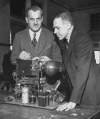 (Born
September 10, 1892: Died March 15, 1962) (Born
September 10, 1892: Died March 15, 1962)
American physicist and engineer. He was a joint winner, with C.T.R. Wilson
of England, of the Nobel Prize for Physics (1927) for his discovery and
explanation of the change in the wavelength of X rays when they collide
with electrons in metals. This so-called Compton effect is caused by the
transfer of energy from a photon to a single electron, then a quantum
of radiation is re-emitted in a definite direction by the electron, which
in so doing must recoil in a direction forming an acute angle with that
of the incident radiation. During WW II, in 1941, he was appointed Chairman
of the National Academy of Sciences Committee to Evaluate Use of Atomic
Energy in War, assisting in the development of the atomic bomb.
March
14:
Space Grapple
In 1994, a magnetic
grappling system was used in outer space for the first time. The 50-foot
robot arm was operated by several Columbia astronauts taking turns.
March
13:
John H. Van Vleck
(Born
March 13, 1899: Died October 27, 1980)
John Hasbrouck Van Vleck was an American physicist and mathematician who
shared the Nobel Prize for Physics in 1977 with Philip W. Anderson and
Sir Nevill F. Mott. The prize honoured Van Vleck's contributions to the
understanding of the behaviour of electrons in magnetic, noncrystalline
solid materials.
March
12:
Michael Idvorshy Pupin
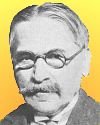 (Born
October 4, 1858: Died March 12, 1935) (Born
October 4, 1858: Died March 12, 1935)
Serbian-American physicist who devised a means of greatly extending the
range of long-distance telephone communication by placing loading coils
(of wire) at predetermined intervals along the transmitting wire. His
parents were illiterate, but they encouraged his education. Pupin became
an instructor in mathematical physics (1890) at Columbia University, New
York City. In 1986, he discovered that atoms struck by X rays emit secondary
X-ray radiation. He also invented a means for taking short-exposure X-ray
photographs. The Bell Telephone Company, in 1901, acquired the patent
for his invention for long-distance telephony. Pupin won a Pulitzer Prize
(1924) for his autobiographical work, From Immigrant to Inventor (1923).
March
11:
Arthur Jeffrey Dempster
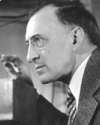 (Born
August 14, 1886: Died March 11, 1950) (Born
August 14, 1886: Died March 11, 1950)
American physicist who built the first mass spectrometer, a device used
to separate and measure the quantities of different charged particles,
such as atomic nuclei or molecular fragments. He used a magnetic analyzer
that focused ions into an electrical collector. His mass spectrography
studies of uranium samples revealed the isotope uranium-235 (1935), the
primary fuel in atomic bombs and reactors.
March
10:
Val Logsdon Fitch
 Born:
March 10, 1923 Born:
March 10, 1923
American particle physicist who was corecipient with James Watson Cronin
of the Nobel Prize for Physics in 1980 for an experiment conducted in
1964 that disproved the long-held theory that particle interaction should
be indifferent to the direction of time. Working with Leo James Rainwater,
Fitch had been the first to observe radiation from muonic atoms; i.e.,
from species in which a muon is orbiting a nucleus rather than an electron.
This work indicated that the sizes of atomic nuclei were smaller than
had been supposed. He went on to study kaons and in 1964 began his collaboration
with James Cronin, James Christenson, and René Turley which led
to the discovery of violations of fundamental symmetry principles in the
decay of neutral K-mesons.
March
9:
Mesons
In 1948, the University
of California at Berkeley and the Atomic Energy Commission officially
announced the artificial production of mesons using the 184-inch cyclotron
at the university's Radiation Laboratory. Time reported the discovery
and hinted that the study of mesons might "lead in the direction
of a vastly better source of atomic energy than the fission of uranium."
March
8:
Otto Hahn
(Born March 8, 1879:
Died July 28, 1968)
German chemist who, with the radiochemist Fritz Strassmann, is credited
with the discovery of nuclear fission. He was awarded the Nobel Prize
for Chemistry in 1944 and shared the Enrico Fermi Award in 1966 with Strassmann
and Lise Meitner. Element 105 carries the name hahnium in recognition
of his work.
March
7:
William Draper Harkins
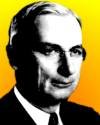 (Born
December 28, 1873: Died March 7, 1951) (Born
December 28, 1873: Died March 7, 1951)
American nuclear chemist who investigated the structure of the nucleus,
and first revealed the basic process of nuclear fusion, the fundamental
principle of the thermonuclear bomb. In 1920, Harkins predicted the existence
of the neutron, subsequently discovered by Chadwick's experiment. He made
pioneering studies of nuclear reactions with Wilson cloud chambers. In
the early 1930's, (with M. D.Kamen) he built a cyclotron. He demonstrated
that in neutron bombardment reactions the first step in neutron capture
is the formation of an "excited nucleus" of measurable lifetime,
which subsequently splits into fragments. He also suggested that subatomic
energy might provide enough energy to power the Sun over its lifetime.
March
6:
Bohr's model of the atom
In 1913, this date
was written by Niels Bohr on his first paper describing his new ideas
on atomic structure, and mailed to his mentor, Ernest Rutherford. It was
one of three historic papers he wrote on this subject.
March
5:
Nuclear Treaty
In
1970- Nuclear non-proliferation treaty goes into effect
March 4:
Atomic power in Antarctica
 In
1962, the Atomic Energy Commission announced that the first atomic power
plant in Antarctica, the PM-3A, Naval Nuclear Power Unit, was in operation
at McMurdo Sound. Between 1 Jan and 1 Mar 1962, the prefabricated plant
was assembled on Observation Hill by a team of contractors and military
technicians. This source of power was initially chosen when engineers
realized that a fission power plant could operate for years without new
fuel. In 1970, management and funding of all Antarctic operations was
consolidated by President Nixon under the National Science Foundation.
The NSF was to take over the funding of PM-3A as of 1 Jul 1972, but it
was decommissioned that year, and replaced with a diesel electricity generator In
1962, the Atomic Energy Commission announced that the first atomic power
plant in Antarctica, the PM-3A, Naval Nuclear Power Unit, was in operation
at McMurdo Sound. Between 1 Jan and 1 Mar 1962, the prefabricated plant
was assembled on Observation Hill by a team of contractors and military
technicians. This source of power was initially chosen when engineers
realized that a fission power plant could operate for years without new
fuel. In 1970, management and funding of all Antarctic operations was
consolidated by President Nixon under the National Science Foundation.
The NSF was to take over the funding of PM-3A as of 1 Jul 1972, but it
was decommissioned that year, and replaced with a diesel electricity generator
March
3:
William Penny
 (Born
June 24, 1909: Died March 3, 1991) (Born
June 24, 1909: Died March 3, 1991)
British nuclear physicist who led Britain's development of the atomic
bomb. Penney was to Britain as Oppenheimer was to the U.S. He was a prominent
part of the British Mission at Los Alamos during WW II, where his principal
assignment was studying the damage effects from the blast wave of the
atomic bomb, but he became involved in implosion studies as well. Penney's
combination of expertise, analytical skill, effective communication, and
the ability to translate them into practical application soon made him
one of the five members of the Los Alamos "brain trust" that
made key decisions. He was the only Briton to be part of the ten man Target
Committee that drew up the list of targets for the atomic bombing of Japan.
March
2:
J. Carson Mark
 (Born
July 6, 1913: Died March 2, 1997) (Born
July 6, 1913: Died March 2, 1997)
Canadian-born American scientist who, as head of the theoretical division
at the Los Alamos (N.M.) Scientific Laboratory, was instrumental in the
development of the hydrogen bomb. He began at Los Alamos in 1945 as a
collaborator on the Manhattan Project. He joined the staff in 1946 and
became leader of T Division the following year until his retirement in
1973. At the Laboratory, he was involved in the development of various
weapons systems, including thermonuclear bombs. He had a broad range of
research interests, including hydrodynamics, neutron physics and transport
theory. By the 1960s, much of the weapons work had been relocated and
the T division diversified into working with outside agencies and private
industry.
March
2:
Bikini H-bomb test
In 1954, the hydrogen bomb code-named Bravo
was exploded in a test over the Bikini Atoll of the Pacific Ocean. With
explosive power of about 20 megatons of TNT it was the most powerful of
all U.S. thermonuclear bomb tests. Radioactivity made the islands an unsafe
wasteland, preventing the evacuated indigenous people from returning for
many decades to follow.
March
1:
Radioactivity discovered
In
1896, Becquerel discovered radioactivity when he developed the photographic
plate he left in a desk drawer and found it had fogged with the image
of the uranium compound crystals resting on it. Thus, the discovery was
in fact the result of a chance occurrence. He had originally stored objects
together on February 26, after postponing his intended experiment on phosphorescent
emissions stimulated by the sun. Instead he now found spontaneous and
penetrating rays, independent of any input of energy. The mysterious nucleus
of the atom had been revealed, but realizing that took more years of research
by other scientists. He received a share of the 1903 Nobel Prize with
Pierre and Marie Curie for their work on radioactivity.
Click
here for previous months
February
January
Photos
courtsey of Today in Science
|

